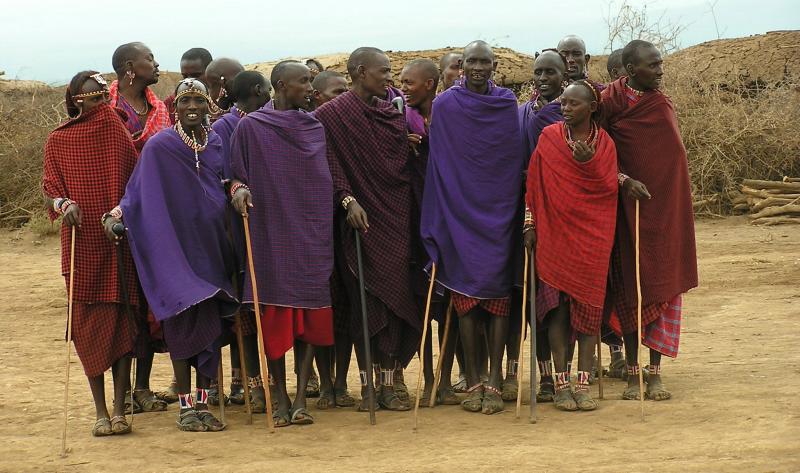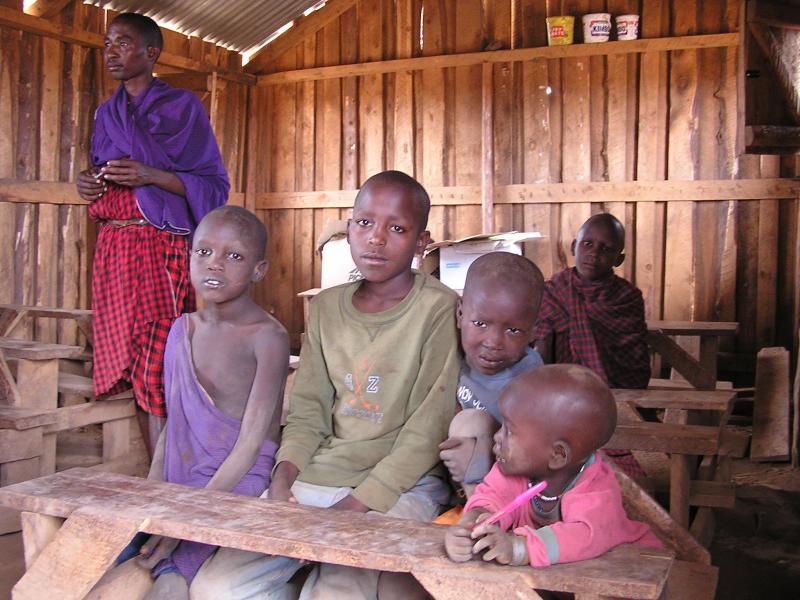|
 |
 |
Masai Mara Village
- Sunday, January 04, 2004 |
 |
 |
 |

Duncan arranged for us to visit a Masai Mara village somewhat close to the lodge. This tribe of people has inhabited Kenya and Tanzania for centuries and maintains their ancient lifestyle. Chief Raphael welcomed us to his village which was followed by a welcome dance by his tribe which involved much singing and jumping. At the end of the dance, the tribesmen surround us both and asked us to kneel for a prayer. They are practicing Christians, but we couldn?t understand the prayer because it was in Swahili. They prayed for rain for the area, rain for us when we go home, and that our visit would bring rain to their village.

Chief Raphael?s village has 134 people and is the main village for the surrounding Masai community of ~1200 people living in similar, smaller villages. The houses are made by the women and consist of a stick frame and ceiling coated in elephant dung. The ceiling is low, the simple floor plan is designed to funnel wind through their homes to keep the air fresh and the smoke from cooking to vent. In a space of 8x10ft, up to eight people live in two bedrooms without a common area.
The Masai eat strictly meat, blood, and milk. The men tend the herds of cattle (goats, cows, and sheep) as this is their only source of food. The women are responsible for the home: building it, cooking, caring for children, and keeping the village clean. Masai practice polygamy. It is not uncommon for Masai men to have many wives and live in many homes. When we met the medicine man, he showed us various natural remedies for illnesses. The Masai have no diseases except Malaria. The Masai burn Olohopheen in their stoves to ward away the mossies (sounds like citronella). The cure for malaria is to boil Meliphora (looks like bark), drink it, then throw up to release the toxins from the body. Apparently it works, though I think we?ll stick to taking our western meds! Chief Raphael also told us about a very popular drug with the men of the village used to help keep up with their many wives ? Orporoquay (similar to Viagra).
The Masai wear very simple, colorful sheets that have been soaked in a natural solution that wards off animals, particularly lions. Most of the sheets are red, a color which repels the animals as well. Every Masai is heavily adorned with colorful, beaded jewelry: arm, wrist, and ankle cuffs, thick necklaces, heavy earrings, belts, and hairpieces. All Masai have close cropped hair except for young males up to age 22 who have long beads. Only after their rite of passage into manhood, the killing of a lion with a spear, can their heads be shaved. Side note: the government and the Masai are now working together to come up with a new ritual instead of killing the dwindling population of lions.
We watched some of the men play a game similar to backgammon, and boy were they competitive! The chief asked some men to demonstrate how they make fire quickly: much like the Boy Scouts teach, a hard wood stick is spun against a piece of soft wood and embers fall down onto elephant dung which then ignites. The men worked in a pair in spinning the stick as to not tire out too fast. Chief Raphael separated us then paraded us through an area when each tribe member showcased their crafts. Good tactic. We ended up buying a few things and did fairly well with our bargaining skills!
Before leaving the village, we took a quick trip to the school house. The 15x30 ft building houses 78 students. It looks like something from a poor city from ?Little House on the Prairie?. The chalkboard is tiny and ancient. Kids practice writing on the dirt floor. Letters, numbers, and days of the week are handwritten on the walls. Students are taught Swahili and English. Kids walk from nearby villages daily for lessons. Sunday is for Bible study.

Some Masai villages allow visitors, but most do not. These few villages are happy to educate outsiders to a point. No sleeping over is permitted or stays longer than an hour. When we asked if the tribe was becoming influenced too much by the visitors, we received a resounded ?no way!? Giving people a glimpse into their culture is profitable for them without being too invasive. Chief Raphael?s village is the only village in their community in which visitors are allowed. The money from selling their wares goes directly into supplies for new homes and school supplies. All in all, it was a fascinating visit.
|
 |
 |
 |
 |
 |
|
|











